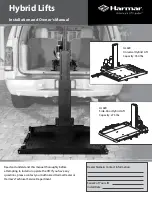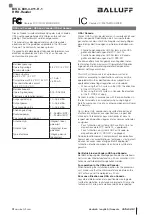
14
5.4.5 The rope removed from the jamming cleat
must be guided during the evacuation process
by allowing it to lightly slip through the hand.
The rope must be lead through the friction
diverter during the whole evacuation process.
5.4.6 The descending speed will be controlled
automatically by a centrifugal brake. It is also
possible to interrupt the descent by braking
(holding) the upward travelling trailing rope
with the hand.
WARNING
It must be ensured that the ascending rope does
not catch or hook on an obstacle as this would
consequently interrupt the evacuation process.
Ensure that the person(s) do not collide with an
obstacle during the descent.
5.5
Simultaneous recovery of victim
and rescuer
The simultaneous evacuation of two persons
allows a victim to be lowered under accompanying
supervision (
Figure 14
, page 13).
5.5.1 The rescuer can descend simultaneously with
the victim when the rope reserve is already
located on the ground. This process is only
permitted up to a maximum evacuation height
of 650 ft. (200 m).
5.5.2
Both persons to be evacuated must wear a full-
body harness.
5.5.3
Upon anchoring the derope
®
descent device to a
structural element with a sufficient load-bearing
capacity, the rescuer ensures the trailing rope
is passed into the friction diverter, so it can be
clamped in the jamming cleat, and descends to
the victim while controlling the trailing rope.
5.5.4
Upon reaching the victim, the rescuer attaches
the victim’s back D-ring to his own frontal
attachment point using a 1 ft. (0.3 m) lanyard.
Upon ensuring of the proper connection holding
the victim to the rescuer frontal attachment
point, the rescuer can cut the victim’s lanyard
from it’s anchorage point.
DANGER
Prior to releasing the fall protection sub-system,
usually a shock-absorbing lanyard, ensure the
victim is properly connected to the extremity of the
evacuation rope.
5.5.5 Both persons can now evacuate by releasing
the rope being held. The descending speed will
be controlled automatically by a centrifugal
brake. It is possible to interrupt the descent by
holding the ascending trailing rope by hand.
6.
MARKING AND LABELING
6.1
Read and comply with all markings and/or labels
on the derope
®
descent device. The markings
and/or labels must be intact and easy to read.
6.2
The derope
®
descent device is marked and/or
labelled as shown in
Figure 15
.
WARNING
Never remove a label from a piece of equipment.
7.
MAINTENANCE AND STORAGE
7.1
Failure to maintain and store equipment
carefully can result in damage and malfunction
that could lead to serious or fatal injury.
7.2
Storage
The rescue equipment should be stored in a
dry and cool room and protected from UV light.
Avoid contact with acids, caustic liquids and
oils. Prior to storing rope ensure it has been
dried without any exposure to direct heat.
7.2.1
Prior to storing the rescue device an inspection
is recommended to allow a quicker access when
required. Upon meeting inspection requirements
the device should be stored in an equipment
bag that would prevent external deterioration
and allow proper transportation to required
site. The bag should be “locked” in a manner to
prevent any tampering and ensure all the rescue
equipment is ready for use.
7.3
Cleaning
Most of Tractel
®
’s equipment can be washed
with a solution of cold water and mild
detergent. After washing and brushing with
a synthetic brush, rinse thoroughly with clear
water and hang to dry, out of the sun and away
from exposure to high heat. Metallic equipment
such as the derope
®
descent device and
carabiner must be dried thoroughly to avoid
corrosion. Items can be washed whenever
needed to extend their lives. They will also be
easier to inspect for damage. Do not use any
cleaning solvent agents, acids etc. as they may
seriously damage the equipment.
Содержание derope Up A
Страница 15: ...15 Fig 15...






































